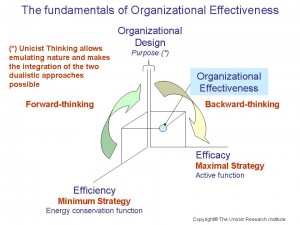 Organizations are typical adaptive systems. If they were not, they could not survive. The Unicist Standard for an organizational process requires having found the real characteristics of the external and internal environment in order to develop such process based on reality and not on a hypothetical reality.
Organizations are typical adaptive systems. If they were not, they could not survive. The Unicist Standard for an organizational process requires having found the real characteristics of the external and internal environment in order to develop such process based on reality and not on a hypothetical reality.
Every design must include the integration of efficacy and efficiency in order to achieve the effectiveness that is required by the environment. If the organization has decided to introduce continuous improvement, it is necessary to include business objects to minimize the change of any improvement.
The taxonomic steps for an organizational design are the following:
1) Japanese Park – A pilot test to confirm the starting point.
2) Definition of Responsibilities – To allow dealing with the organization as an adaptive system.
3) Clarification of the Methodology – Defining the taxonomic approach to deal with the processes.
4) Definition of the final objective – Confirming the “use value” of the organizational process.
5) Definition of the Methods – Definition of the methods to be followed. These methods are derived from the methodologies of step 3.
6) Evaluation & Adjustment of Costs.
7) Validating the “use value” of the organizational process in action.
These steps are taxonomic, which means that the sequence has to be respected. When the step 1 has been finished, the adaptive system is being born.
